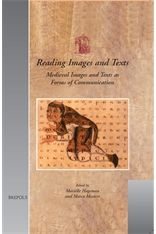 Reading Images and Texts: Medieval Images and Texts as Forms of Communication: Papers from the Third Utrecht Symposium on Medieval Literacy, Utrecht, 7-9 December 2000, ed. Mariëlle Hageman and Marco Mostert (Turnhout, 2005: USML 8), x+563 pp. ISBN 2-503-51437-5.
Reading Images and Texts: Medieval Images and Texts as Forms of Communication: Papers from the Third Utrecht Symposium on Medieval Literacy, Utrecht, 7-9 December 2000, ed. Mariëlle Hageman and Marco Mostert (Turnhout, 2005: USML 8), x+563 pp. ISBN 2-503-51437-5.
Relations between images and texts have benefited from an increase in scholarly attention. In medieval studies, art historians, historians, codicologists, philologists and others have applied their methods to the study of illuminated manuscripts and other works of art. These studies have shifted from a concern about the contents of the messages contained in the artefacts (e.g. in iconography) to an interest in the ways in which they were communicated to their intended audiences. The perception of texts and images, their reception by contemporaries and by later generations have become topics in their own right. According to some, medieval images may be ‘read’. According to others, the perception of images is fundamentally different from that of texts. The analysis of individual manuscripts and works of art remains the basis for any reconsideration of their transmission and uses. The interactions between non-verbal and verbal forms of communication, more in particular the relations between visual symbols other than writing and the recording of speech in writing, are important for the evaluation of both images and texts.
Contents:
Marco Mostert, “Reading Images and Texts: Some Preliminary Observations Instead of an Introduction”
Herbert L. Kessler, “Corporeal Texts, Spiritual Paintings, and the Mind’s Eye”
Lawrence G. Duggan, “Was Art Really the ‘Book of the Illiterate’?”
Lawrence G. Duggan, “Reflections on ‘Was Art Really the “Book of the Illiterate”?'”
Claudine A. Chavannes-Mazel, “Paradise and Pentecost”
William J. Diebold, “Changing Perceptions of the Visual in the Middle Ages: Hucbald of St. Amand’s Carolingian Rewriting of Prudentius”
Michael Curschmann, “Oral Tradition in Visual Art: The Romanesque Theodoric”
Rosamond McKitterick, “Perceptions of the History of the Church in the Early Middle Ages”
Wolfert S. van Egmond, “Saintly Images: Visions of Saints in Hagiographical Texts”
Mariëlle Hageman, “Pictor Iconiam Litterarum: Rituals as Visual Elements in Early Medieval Ruler Portraits in Word and Image”
Giselle de Nie, “Paulinus of Nola and the Image Within the Image”
Karl F. Morrison, “Meditations on a Christmas Card: Strategies of Empathy in a Fourteenth-Century Liturgical Illumination”
Barbara Baert, “The Wall Paintings in the Campanile of the Church of S. Nicola in Lanciano (c. 1300-1400): Reading an Unknown Legend of the Cross in the Abruzzi”
Caecilia Davis-Weyer, “Cum ipso sunt in hac nativitate congeniti: Dove, Throne and City in the Arch Mosaics of Sta. Maria Maggiore in Rome (432-440)”
Eric Palazzo, “Les Peintures de la Crypte de Tavant: État de la Question et Perspectives de Recherche”
Anna Adamska, “La Piété Princière dans l’Image et la Parole: La Plaque de Wiślica (Petite Pologne) de la Deuxième Moitié du XIIe Siècle”
Esther Mulders, “The Ambiguity of Eros: An Image of the Antique God of Love in a Christian Encyclopaedia”
Henry Mayr-Harting, “Ottonian Tituli in Liturgical Books”
Michel Kaplan, “Texte et Image dans le Manuscrit de Madrid de la Chronique de Skylitzès”
John Lowden, “‘Reading’ Images and Texts in the Bibles moralisées: Images as Exegesis and the Exegesis of Images”
Xavier Barral i Altet, “Les Images de la Porte Romane comme un Livre Ouvert à l’Entrée de l’Église”

